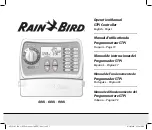
Chapter 1
Installing and Configuring the SCXI-1126
1-4
ni.com
Frequency-to-Voltage Conversion Stage
This stage consists of the following:
•
A pulse generator, which triggers on the incoming frequency to
produce a pulse per frequency cycle with a precisely controlled pulse
width that is set by the input frequency range.
•
A 1-bit DAC, which uses a stable voltage reference to translate the
amplitude of the pulse train to the output voltage range.
•
A programmable, 4-pole, active lowpass filter, which averages the
output of the 1-bit DAC to produce a clean analog voltage proportional
to the input frequency. You can program the filter to any of four
bandwidths: 1 Hz, 40 Hz, 320 Hz, or 1 kHz. This added flexibility
allows you to reduce the channel response time by selecting a higher
filter bandwidth for input frequencies that exceed the minimum
recommended value for the selected filter bandwidth. The minimum
recommended input frequency for each filter bandwidth is listed in
Appendix A,
Note
Because of the low bandwidths of the output filters, you must wait approximately
3 s after changing any of the settings to allow the channels to settle before you can take an
accurate measurement. NI-DAQ automatically queries the module to determine when the
module outputs have settled.
Analog Output Stage
The output stage consists of the following:
•
A buffered analog multiplexer, which multiplexes the outputs of all
eight channels to a buffer. The buffer output connects directly to CH0
on the rear signal connector.
•
The analog bus switch circuitry, which can route the buffer output to
AB0 on the SCXIbus connector instead of CH0 under software
control. If the SCXI-1126 is the cabled module, you can configure the
analog bus switch circuitry to route a signal placed on AB0 by another
SCXI module, using the output buffer, to CH0 where it can be read by
the E Series DAQ device. When a signal passes on the SCXIbus from
the scanned module to the E Series DAQ device through the cabled
module, the measurement is called
indirect scanning
. When a signal
passes directly from the cabled module to the E Series DAQ device, the
measurement is called
direct scanning
. Figure 1-1 illustrates the signal
paths controlled by the analog bus switch circuitry.
You can software configure the output stage for two modes of
operation—multiplexed mode or parallel mode.












































